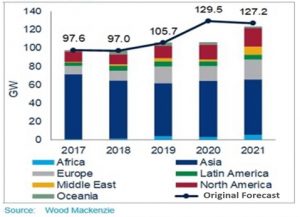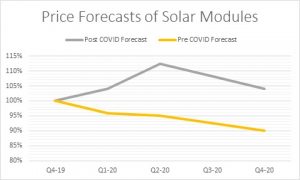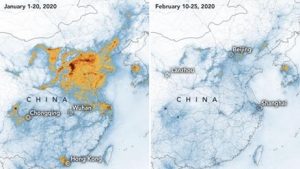Officially confessed and announced as a global Pandemic, the COVID-19 has forced countries to cancel flights, lock down airports, seize export and import, and improvise various measures to restrict the movement of people. Zooming to the solar sector, the effect of the Pandemic was very significant on the entire industry. In a nutshell, we aim to present in this article the impact of this never seen virus on the solar industry in general, and resume with a pragmatic outlook for the post corona phase.
Impact on Supply Chain
Given that the virus originated in China with a very severe outbreak, and since China is considered as the “world’s factory” of Solar equipment responsible of more than 70% of the worlds’ solar production, the industry has inevitably been affected by the Chinese massive lockdown of its Giga solar facilities. Major manufacturers of photovoltaic panels and batteries in China have shut down their operations for several weeks, leaving behind the piled-up orders in their pipelines from all around the world, which led to a global and painful shortage, and consequently to unframed delays in projects’ deliveries.
Even for the factories that decided to challenge the pandemic by resuming its productions, they were struggling to attain the necessary raw materials from one side, and suffering from scarcity in logistics from the other side of the supply chain. They were even banned from importing their goods to some countries who blocked the shipments fearing any possible contamination that may accompany the imported goods.
Impact on global solar installations
It is expected that the overall solar installations in 2020 to drop by 18%. Construction is slowing, tenders are postponed, and for early-stage projects, there are more hesitations about their reserved budgets and financing. As a result, Wood Mackenzie has suppressed its forecasts by 18%, from 129.5 gigawatts to 106.4 gigawatts. For instance, in India alone, 3000 MW of solar and wind energy projects have been delayed. Even more, Wood Mackenzie’s forecast for 2021 has also been reduced, though more softly, by 3%, from 127.2 gigawatts to 123.6 gigawatts.
The figure below describes the original solar growth forecasts versus the new modified forecasts with the pandemic effects factored in.

Breaking it down by continent, the below graph demonstrates the anticipated installation shares among the regions for this year and the coming year.

Statistics show that the projects being in early-stage development, and small & mid-size projects are expected to be the most impacted by the pandemic. As for utility scale-projects, they are also effected, but once the production resumes, such projects will be prioritized hence further pushing the smaller jobs to supply starvations and further delays
Impact on Prices
Analyzing and projecting the supply-demand graphs, the initial forecasts of 2020 originally signaled a possible price drop of around 10% in solar prices over the year. However, the pandemic advent shuffled the forecasts and changed the game. The new facts showed an acute increase in prices in Q1 2020 which is anticipated to further increase in Q2 to hit 12.5%. Factories are then expected to resume their operations starting Q3 & Q4, hence shrink the supply-demand gap which will reflect on the prices to show a downward dip.
The below Graph summaries the % price increase over the year 2020.
Impact on technological developments.
When the winds are high, wise fishermen invest their times fixing their nets. The Covid-19 has certainly delayed production and locked down doors, but still gave room for “wise” players in the industry to focus on their R&D aiming to maintain their edge and score a leap ahead. They know well that their developments will strengthen their position in the post Corona phase and accelerate their comeback. For instance, a U.S. research group has recently announced their development of a new solar cell based on six active photoactive layers, to capture light from a specific part of the solar spectrum. The scientists claim that they could potentially reach a 50% efficiency rate with the new cell.
On the other hand, some factories decided to shift their production facilities to escape starvation. An Indian state-owned solar manufacturer Central Electronics planned to turn over its solar wafer facilities to start producing ventilators, a highly needed product in these days.
Solar vs Fuel
In most economies that have taken stringent measures in containing the virus, the electricity demand has declined by around 15%, primarily as a result of factories and businesses halting their operations. Consequently, some debaters in the industry fear a drop in the solar demand in the short term as the prices of oil is hitting a never seen rock-bottom. They claim that solar investments may recess as long as its levelized costs are not lower than that of traditional fossil fuels. However, other analysts are pretty confident that the demand on solar will remain increasing exponentially to surpass that of highly polluting fuel. Even if the industry faces a small blip in the near future post the lockdown, the overall go-green trends, fuel scarcity, and ambitious net-zero and renewable-to-conventional energy share targets that most companies have set will keep the solar as the primary energy option, consequently a lucrative industry for investments.
According to a recent report, the International Renewable Energy Agency advised that ongoing investments in the solar energy could generate huge economic benefits by catalyzing global GDP gains of almost USD 100 trillion between now and 2050.
Andrew Steer, chief executive of the World Resources Institute, said: “As the world looks to recover from the current health and economic crises, we face a choice: we can pursue a modern, clean, healthy energy system, or we can go back to the old, polluting ways of doing business. We must choose the former.”
Outlook
Forecasting an accurate impact of this pandemic over the solar industry is practically impossible due to high uncertainties and many uncontrollable parameters in the scene. What we know as a fact is that the whole world is proactively working deliberately to combat the spread of the virus and are setting the guidelines of un-locking the economy to return the wheels on track. China has already entered the post Corona phase and solar manufacturers are jumping back to action. The current pace allows us to anticipate a gradual recovery to normal supply levels starting the second half of 2020.
We are certain that following every recession a bounce-back is inevitable. However, the road uphill may be somehow exhausting and bumpy. Not aiming to sound gloomy but a second COVID wave is very possible to occur, so our advice is to learn from this experience, take the right measures, and be prepared for what comes next. With all the downturns of Corona, it has been proven that the world has taken a break from mankind’s aggressive waste and pollution footprints. The figure below says it all, and gives us the definitive motive to believe that no matter what the upcoming outlook is, it shall be tackled from a “green” perspective!

Nitrogen dioxide emissions over China – Copyright NASA Earth Observatory by Joshua Stevens, using modified Copernicus Sentinel 5P data processed by the European Space Agency NASA.
According to one analysis, the slowdown of economic activity in China led to an estimated 25% reduction in Carbon footprints in only 4 weeks!

